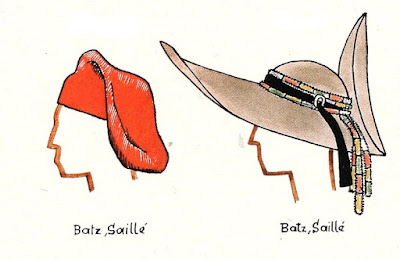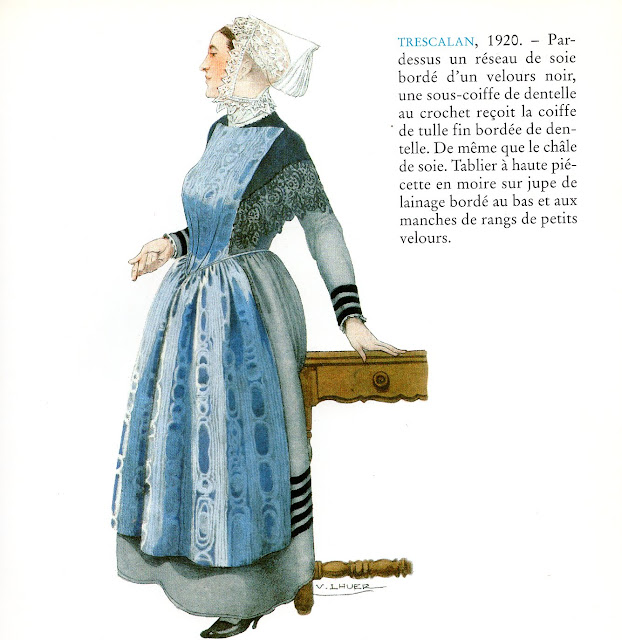Today I will continue this series about Breton Costumes by talking about the province of Nantes, specifically about the costumes of the region of Gwenrann, or Guerande.
Pays Nantais in French
Bro Naoned in Breton
Paeï de Nàntt in Gallo
The province of Nantes has always been an integral part of Brittany. When the French government instituted the current administrative divisions called departments, The Province of Nantes was renamed the department of Loire Atlantic, with similar borders. When the departments were grouped into regions, however, Loire Atlantic was taken away from Brittany and attached to a new group called Pays de la Loire. Neither the Breton people or the Nantais have recognized this, and continue to lobby that it be officially returned. This is why some modern maps of Brittany do not include this province. Here is a banner from a Festival in Guingamp in 2019. It is clearly advocating the reunification of the Nantes region with the rest of Brittany.
I have watched several videos of the parades associated with these festivals. The Breton flag is everywhere, but the French flag is conspicuous by its complete absence.
This province has historically had three languages. Breton was the majority language on the Guerande peninsula into the 20th century, and there are currently efforts to revive it. In most of the rest of the Province, Gallo was spoken. In the southern part of Retz, the local language was Poitevan.
Bro Gwennrann or Pays Guérandais
The peninsula has always had a unique culture, and the costumes here are very different from those in the rest of Nantais. Breton was the majority language here untill recently, and this may be considered part of Lower Brittany. Here is a physical map of the peninsula.
The most important feature that you will notice is the sharp escarpment which runs from the northwest to the southeast. The city of Gwennrann or Guérande is located in the middle of this ridge. The the south lie the 'white lands', the salt marshes, home of the people that the French call Paludier, and north lie the 'black lands', the peat bogs, home of the people that the French call Metayer. On the peninsula in the southwest, two cities form their own distinct costume areas within this region; Croisic and Pouliguen. Here is Guesdon's map of these costume areas, which is more detailed and accurate than Creston's.
1. The Swamp Dwellers, [Paludier], including the towns of Batz and Guerande, as well as many villages in the area, consisting of the salt marshes and the land immediately surrounding them.
2. The Bog Dwellers, [Metayer], including the town of Escoublac and the black lands north of the escarpment.
3. The town of Croisic.
4. The town of Pouliguen.
The image at the head of the article is of people from this region. The first rank are Swamp Dwellers, and the second and third ranks are Bog Dwellers. In a land of flamboyant costumes, this is among the most colorful.
Swamp Dwellers
In a land of big round hats, the men of this region still manage to stand out. The hats are of unusual size. While at times they wear wool toques, similar to those of Portugal, Sardinia, and many other coastal regions, they are known for the hat pictured here on the right.
The hats are extremely large, have one side folded up and secured by laces through the top, and are garnished with a ribbon and buckle, and multiple strands of multicolored chenille.
It would be logical to assume that these hats developed for shade during work, but were very impressive when worn with the festive dress.
The main occupation of the men in the salt marshes was the gathering of salt from salt pans. These were flooded with seawater, and the salt gathered as it evaporated.
White shirt, white smock with a placket on the chest with hand openings, full Breton style knickers, [bragous bras] tied with a white linen garter, white gaiters, and low yellow deerskin suede shoes. The hat must have been useful out in the sun.
There are certain differences between the costume of the north shore of the lagoon Selak or Saillé, and the south side Bourc'h-Baz or Bourg de Batz, today called Batz sur mer.
On the north side, the hat was worn with the fold in back, and the big round brim in front.
If single, with the fold on the left.
On his wedding day, with the fold on the right.
And when widowed, with the fold in front. I have been unable to find a photograph of this, but here is Creston's sketch of the hat and its possible positions. The widower is shown at the bottom right.
However, you will see many photos that seem to ignore this rule.
For the dress costume, the gaiters and smock are left off. The shirts have wide collars, often ornamented with lace, and white wool vests are worn, often more than one, as you can see in the above photo. The vests are long, covering the upper hips, and are double breasted, as is common in most of Brittany.
If layered each succeeding vest is shorter than the one before, allowing the ornamented edge of the first vest to show. Here we see a group from Trescalan on the north bank performing in everyday costumes one step dressier than the work outfits. In this case the vests are not ornamented on the hem.
Over the vests, an underjacket is worn, with is hooked closed around the waist. This has galloon which is appliqued in two rows, one which goes all the way down, and one which turns at the level of the hook.
They are traditionally dark blue. This image shows men's and women's dress stockings at the bottom.
For women, work clothing consists of chemise, underskirt, skirt, apron, and often two kerchiefs worn over the head. The skirts were hiked up by tying a fingerwoven band around the hips. Square-ish containers were balanced on the head for transporting salt.
For more everyday occasions when not working in the salt pans, aprons with or without bibs were worn, often tied with a solid colored band. The coif consisted of two parts. The undercoif was like a cap, with a rolled edge. This roll was visible when the entire coif was put on.
The coif itself is similar to that of Baud, the emphasis being on the front part and wings, which hung down possibly to the shoulder. If you look just above, you can see the women wearing the plain linen form of this coif. For the dress coif, there are two versions; one for Batz and the villages south of the lagoons, and the other for Saille and the villages to the north.
For Batz, the coif is basically made up of just the lappets, the rear has been eliminated. For dress, this is embroidered and often made of lace.
The coif of Saille and the north bank of the swamps had an extended rear, which was gathered in the back of the coif.
The dress bodice has wide square armholes and full sleeves with a turned back cuff ornamented with brocade. For unmarried girls the bodice was white with black edging, and is worn with an apron that has no bib, but there is an ornamental ribbon worn around the waist.
For married women, the bodice is more elaborate, and the apron has a bib, in the most dressy version, the bib is stiff and quilted. This is the version which is worn for weddings
The city people of the region had a somewhat different costume, which was worn on occasions less formal than that of full dress. The apron had a bib which was less elaborate, and the outfit often included a shoulder shawl which was sometimes embroidered. This outfit somewhat resembled that of the Metayer, but used the coif of the Paludier.
I had intended to cover more in this article, but I shall end here, and just give a few more images of the Paludier costume.
Thank you for reading, I hope that you have found this to be interesting and informative.
Roman K.
email: rkozakand@aol.com
Source Material:
Victor Lhuer, 'Les Costumes Bretons', 2001
Pierre Jakez Helias, 'Coiffes et Costumes de Bretagne', Chateaulin, 1983
Josepj Jigourel & Yanna Fournier, 'Costumes de Bretagne', Brest, 2000
Bruno Helias, 'Breton Costumes', Florence, 1997
Yann Guesdon, 'Costumes de Bretagne', Quimper, 2011
Yann Guesdon, 'Coiffes de Bretagne', Spezet, 2014
R. Y. Creston, 'Le Costume Breton', Paris, 1974
Charles Freger, 'Portraits in Lace - Breton Women', London, 2015
Jean-Pierre Gonidec, 'Coiffes et Costumes des Bretons', Spezet, 2021
Pierre Rochereau, ' Coiffes et Costumes des Bords de Rance', Dinan, 1989
Simone Morand, 'Coiffes et Costumes de l'Ancien Comte de Rennes', Quimper, 1979





















































































































No comments:
Post a Comment